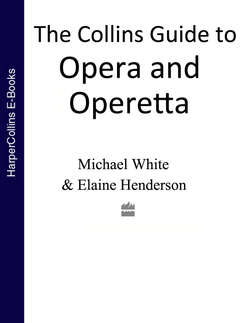Читать книгу The Collins Guide To Opera And Operetta - Michael White - Страница 20
ОглавлениеLulu
FORM: Opera in three acts; in German
COMPOSER: Alban Berg (1885–1935)
LIBRETTO: Alban Berg; from two plays by Frank Wedekind
FIRST PERFORMANCE: (Complete) Paris, 24 February 1979
Principal Characters
Lulu Soprano
Dr Schön, a newspaper editor Baritone
Alwa, his son Tenor
Schigolch, an old man Bass-baritone
Lulu’s admirers and lovers
Countess Geschwitz Mezzo-soprano
The Painter Tenor
The Athlete Bass
The Schoolboy Mezzo-soprano
The Marquis Tenor
The Banker Bass
The Prince Tenor
Synopsis of the Plot
Setting: Setting: Germany, Paris and London; late 19th century
ACT I Lulu is having her portrait painted as a present, but is caught in a compromising situation with the Painter by her husband, who drops dead from shock. Lulu marries the Painter and is living in some luxury; she has, as Schigolch points out, ‘come a long way’. Dr Schön, one of Lulu’s lovers, comes to tell her that they must stop seeing each other as he is getting engaged, at which Lulu protests vehemently. After she has gone Schön tells the Painter all about her colourful past and the many names by which she was known to her former lovers. The Painter is so distressed that he kills himself. Free again, Lulu compels Schön to call off his engagement.
ACT II Schön and Lulu are now married, but Schön is consumed with suspicious jealousy over Lulu’s many admirers, including his own son, Alwa. Schön overhears Alwa declaring his love for his stepmother and suggests to Lulu that she should end her own life. Lulu, almost distractedly, takes up the gun and shoots Schön.
In a silent, filmed interlude, we learn that Lulu has been jailed for murder. She has contracted cholera, transmitted to her on purpose by Countess Geschwitz, to enable her to escape from the hospital. Lulu, Schigolch and Alwa leave for Paris.
ACT III Lulu is surrounded by a crowd of disreputable characters in a Parisian casino. The Marquis, having failed to blackmail Lulu into joining a Cairo brothel, informs the police of her whereabouts but she manages to escape just in time. Her final home is a dingy attic in a London slum where she supports herself, Alwa and Schigolch by prostitution. They are joined by the faithful Geschwitz. In this final, dark episode of her life Lulu sees Alwa killed by one of her clients before she herself, together with Geschwitz, is murdered by Jack the Ripper.
Music and Background
Lulu is a difficult, abrasive and altogether demanding piece, written for a large orchestra, with a bizarre assortment of characters who give the otherwise dark plot a surreally comic edge. It is constructed entirely from a single row of twelve notes in the closest Berg came to total Serialism. However anarchic it sounds in performance, the score actually works according to meticulously organised formal principles, and for ears accustomed to its sound-world, it presents a curious kind of beauty. Berg died before finishing the orchestration of the last act, and his widow prevented completion of the score by other hands during her lifetime. As a result, Lulu had no complete staging until 1979.
Highlights
For anyone less than steeped in its idiom, the big moments of Lulu will be dramatic rather than musical, including the pivotal film sequence in Act II (where the second half is supposed to be a palindromic mirror-image of the first), and the horrendous death of Lulu at the end (a gift for directors with a lurid imagination).
Did You Know?
Berg’s widow forbade completion of the score for personal reasons: she believed Lulu – probably correctly – to be an oblique portrait of that same lover who features in the code of the Lyric Suite.
Recommended Recording
Teresa Stratas, Franz Mazura, Kenneth Riegel, Paris Opera/Pierre Boulez. DG 415 489-2. A lucid account of the complete score by the cast and conductor responsible for the 1979 premiere.
